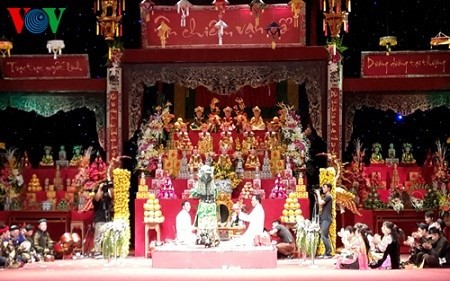 A chanting-trancing session to honor the Mother Goddesses. A chanting-trancing session to honor the Mother Goddesses. |
The worship of Mother Goddesses is a combination of Vietnam’s indigenous religion with some characteristics of Buddhism and Taoism. It’s a form of worship for the Mother incarnating as Mother Saint and female deities who manage the skies, rivers, forests and mountains.
The Mother Goddesses originated from the Kinh people and other ethnic minority groups such as the Mường, Tày, Nùng, and Dao. It shows a cultural exchange, equal relations, and harmony among ethnic groups.
In ancient documents and legends, Mother Saint Lieu Hanh was referred to as Mother of the World (Mau nghi thien ha), a nymph who descended to Earth, lived as a human and became one of four immortal saints of the Viet people. She is “Mau Thuong Thien”, the first Mother Goddess with the power to manage the heavens and master supernatural forces such as clouds, rain, wind, storms, thunder and lightning.
 A procession of the second Mother Goddess of the Forest at Dong Cuong Temple Festival in Yen Bai province. A procession of the second Mother Goddess of the Forest at Dong Cuong Temple Festival in Yen Bai province. |
Since the 16th century, this belief has been a popular religious practice in society.
“The worship of Mother Goddesses has been practiced far and wide in Vietnam’s history. In the mind of Vietnamese people, they have supernatural power. In primitive time when people lived in forests, they worshipped the Forest deity. Then they cultivated lower land areas and formed a system of female deities or Mother Goddesses,” said Professor, Doctor Tran Lam Bien, a researcher of cultural heritages.
In Vietnam, the belief of Worship of Mother Goddesses appears in many localities, but Nam Dinh province is considered one of the hubs with some 400 Mother Goddess Worship locations, of which Phu Day is the focal point.
Apart from three supreme goddesses, the Mother Goddesses belief also worships about 70 deities, including many historical personalities, national heroes deified by the people, such as Tran Hung Dao and Pham Ngu Lao who contributed enormously to the Tran dynasty’s victories over the Mongol invaders in the 13th century. When they were alive, they were talented, virtuous people who gave great contributions to national construction and defense.
The Mother Goddesses worship demonstrates the national tradition of “remember the source of the water we drink”, the spiritualised patriotism, cultural exchange, and close and equal relationships among nationalities.
“The Mother Goddess worship heritage is closely associated with the ancient belief of worshipping nymphs dating 6 to 7 thousands of years ago. The worship covers many rites such as worship of the Mother Saints, Father Saints, the Jade Emperor, parents, ancestors, and national contributors,” said Le Xuan Nam, former Director of the Nam Dinh provincial Department of Culture, Sports, and Tourism.
The worship of Mother Goddesses culminates in the “Hau dong” or chanting-trancing rite, which implies people’s strong confidence and earnest aspirations for life and encourages people to find mercy and humanity as the foundation of human relations.
Worship of the Mother Goddesses, a symbol of the supreme mother, contributes to promoting the role of Vietnamese women in family and society. Festivals, chanting and trance sessions, worship costumes, music, and dances are ways to restore and promote Vietnamese culture.